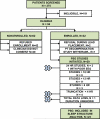Feasibility study of unattended polysomnography in medical intensive care unit patients
- PMID: 25023504
- PMCID: PMC4150840
- DOI: 10.1016/j.hrtlng.2014.06.049
Feasibility study of unattended polysomnography in medical intensive care unit patients
Abstract
Objectives: To evaluate the feasibility of using unattended, portable polysomnography (PSG) to measure sleep among patients in the medical intensive care unit (MICU).
Background: Accurate measurement of sleep is critical to studies of MICU sleep deprivation. Although PSG is the gold standard, there is limited data regarding the feasibility of utilizing unattended, portable PSG modalities in the MICU.
Methods: MICU based observational pilot study. We conducted unattended, 24-h PSG studies in 29 patients. Indicators of feasibility included attainment of electroencephalography data sufficient to determine sleep stage, sleep efficiency, and arousal indices.
Results: Electroencephalography data were not affected by electrical interference and were of interpretable quality in 27/29 (93%) of patients. Overnight sleep efficiency was 48% reflecting a mean overnight sleep duration of 3.7 h.
Conclusions: Unattended, portable PSG produces high quality sleep data in the MICU and can facilitate investigation of sleep deprivation among critically ill patients. Patient sleep was short and highly fragmented.
Keywords: Critical care; Feasibility study; Polysomnography; Sleep deprivation; Sleep fragmentation.
Copyright © 2014 Elsevier Inc. All rights reserved.
Figures



Similar articles
-
The Feasibility and Utility of Continuous Sleep Monitoring in Critically Ill Patients Using a Portable Electroencephalography Monitor.Anesth Analg. 2016 Jul;123(1):206-12. doi: 10.1213/ANE.0000000000001330. Anesth Analg. 2016. PMID: 27159066 Free PMC article.
-
Feasibility of comprehensive, unattended ambulatory polysomnography in school-aged children.J Clin Sleep Med. 2014 Aug 15;10(8):913-8. doi: 10.5664/jcsm.3970. J Clin Sleep Med. 2014. PMID: 25126039 Free PMC article. Clinical Trial.
-
Comparison between home and hospital set-up for unattended home-based polysomnography: a prospective randomized study.Sleep Med. 2015 Nov;16(11):1434-1438. doi: 10.1016/j.sleep.2015.04.006. Epub 2015 Apr 28. Sleep Med. 2015. PMID: 26212230
-
Unattended home-based polysomnography for sleep disordered breathing: current concepts and perspectives.Sleep Med Rev. 2014 Aug;18(4):341-7. doi: 10.1016/j.smrv.2013.12.002. Epub 2013 Dec 12. Sleep Med Rev. 2014. PMID: 24388970 Review.
-
Actigraphy to Evaluate Sleep in the Intensive Care Unit. A Systematic Review.Ann Am Thorac Soc. 2018 Sep;15(9):1075-1082. doi: 10.1513/AnnalsATS.201801-004OC. Ann Am Thorac Soc. 2018. PMID: 29944386 Free PMC article.
Cited by
-
Feasibility of Continuous Actigraphy in Patients in a Medical Intensive Care Unit.Am J Crit Care. 2017 Jul;26(4):329-335. doi: 10.4037/ajcc2017660. Am J Crit Care. 2017. PMID: 28668919 Free PMC article.
-
Creating Naptime: An Overnight, Nonpharmacologic Intensive Care Unit Sleep Promotion Protocol.J Patient Exp. 2018 Sep;5(3):180-187. doi: 10.1177/2374373517747242. Epub 2018 Jan 17. J Patient Exp. 2018. PMID: 30214923 Free PMC article.
-
Sleep Quality and Quantity in Intensive Care Unit Patients: A Cross-sectional Study.Indian J Crit Care Med. 2018 Jun;22(6):408-414. doi: 10.4103/ijccm.IJCCM_65_18. Indian J Crit Care Med. 2018. PMID: 29962740 Free PMC article.
-
Atypical Sleep and Postoperative Delirium in the Cardiothoracic Surgical Intensive Care Unit: A Pilot Prospective Study.Nat Sci Sleep. 2020 Dec 8;12:1137-1144. doi: 10.2147/NSS.S275698. eCollection 2020. Nat Sci Sleep. 2020. PMID: 33324127 Free PMC article.
-
Association between death and loss of stage N2 sleep features among critically Ill patients with delirium.J Crit Care. 2018 Dec;48:124-129. doi: 10.1016/j.jcrc.2018.08.028. Epub 2018 Aug 23. J Crit Care. 2018. PMID: 30179762 Free PMC article.
References
-
- Freedman NS, Gazendam J, Levan L, Pack AI, Schwab RJ. Abnormal sleep/wake cycles and the effect of environmental noise on sleep disruption in the intensive care unit. Am J Respir Crit Care Med. 2001;163:451–7. - PubMed
-
- Tamburri LM, DiBrienza R, Zozula R, Redeker NS. Nocturnal care interactions with patients in critical care units. Am J Crit Care. 2004;13:102–12. quiz 14-5. - PubMed
-
- Celik S, Oztekin D, Akyolcu N, Issever H. Sleep disturbance: the patient care activities applied at the night shift in the intensive care unit. J Clin Nurs. 2005;14:102–6. - PubMed
-
- Le A, Friese RS, Hsu CH, Wynne JL, Rhee P, O'Keeffe T. Sleep disruptions and nocturnal nursing interactions in the intensive care unit. J Surg Res. 2012;177:310–4. - PubMed
Publication types
MeSH terms
Grants and funding
LinkOut - more resources
Full Text Sources
Other Literature Sources
Medical

